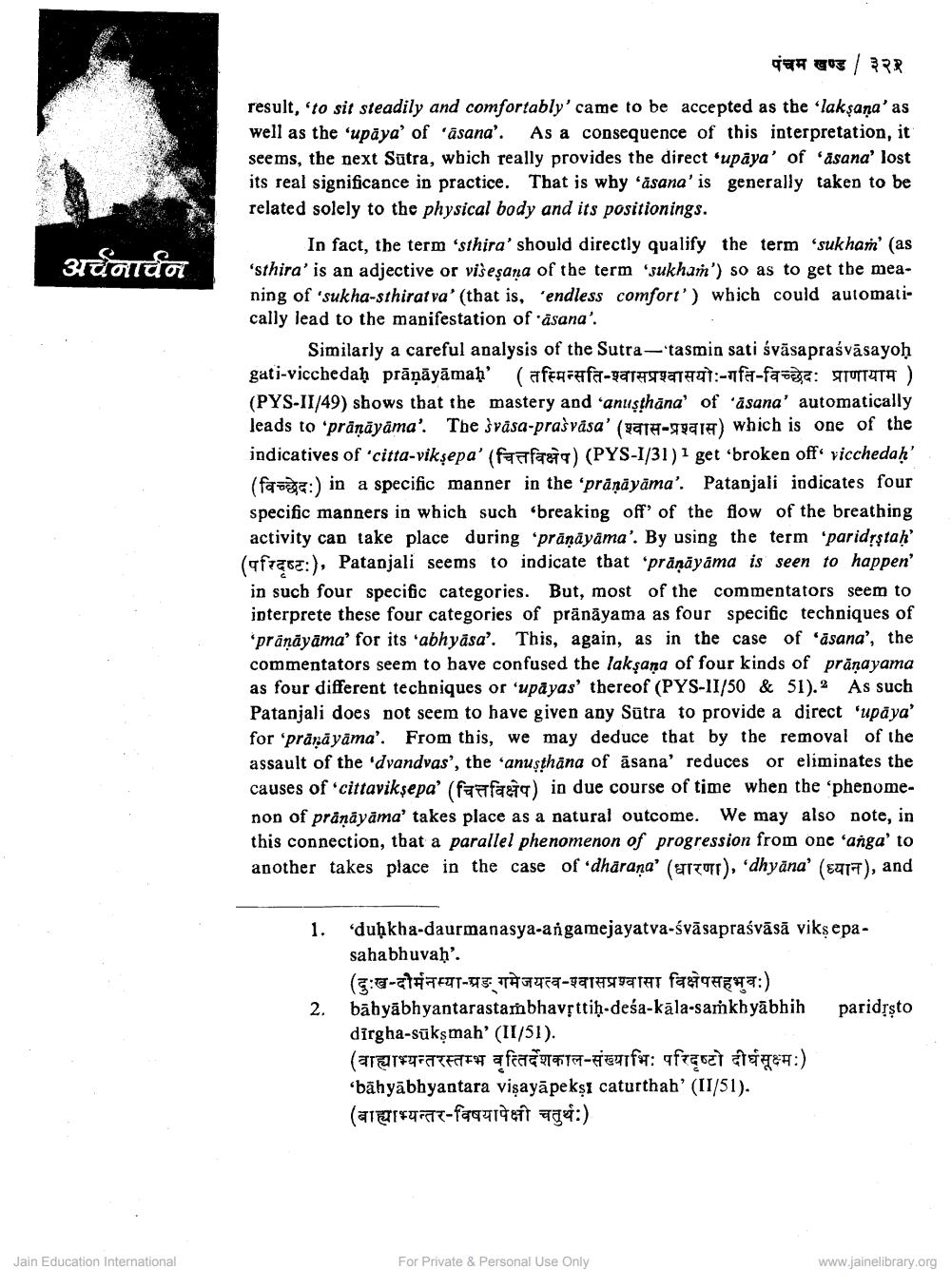________________
पंचम खण्ड/३२१
अर्चनार्चन
result,'to sit steadily and comfortably came to be accepted as the 'laksana'as well as the 'upāya' of 'asana'. As a consequence of this interpretation, it seems, the next Sutra, wbich really provides the direct 'upaya' of 'asana' lost its real significance in practice. That is why 'äsana' is generally taken to be related solely to the physical body and its positionings.
In fact, the term "sthira' should directly qualify the term "sukhan (as 'sthira' is an adjective or višeşana of the term "sukham') so as to get the meaning of 'sukha-sthirat va' (that is, endless comfort') which could automatically lead to the manifestation of asana'.
Similarly a careful analysis of the Sutra-'tasmin sati śvāsapraśvāsayoh gati-vicchedaḥ prāņāyāmah' (afen #fa-gathatnut:-fa-fazesa: STUTATA ) (PYS-II/49) shows that the mastery and 'anusthāna' of 'asana' automatically leads to 'prānāyāma'. Tbe švāsa-prašvasa' (9914-99918) which is one of the indicatives of citta-viksepa' (feafaag) (PYS-1/31) 1 get 'broken off vicchedah' (faza:) in a specific manner in the 'pranayama'. Patanjali indicates four specific manners in which such breaking off of the flow of the breathing activity can take place during 'pranāyāma'. By using the term 'paridıştah' (cfrac:), Patanjali seems to indicate that 'präņāyāma is seen to happen' in such four specific categories. But, most of the commentators seem to interprete these four categories of prānāyama as four specific techniques of *prānāyāma' for its 'abhyāsa'. This, again, as in the case of 'äsana', the commentators seem to have confused the laksana of four kinds of pranayama as four different techniques or 'upayas' thereof (PYS-11/50 & 51).2 As such Patanjali does not seem to have given any Sūtra to provide a direct 'upāya' for 'prānāyāma'. From this, we may deduce that by the removal of the assault of the 'dvandvas', the 'anuşthäna of āsana' reduces or eliminates the causes of cittaviksepa' (faefast) in due course of time when the phenomenon of pränāyāma' takes place as a natural outcome. We may also note, in this connection, that a parallel phenomenon of progression from one 'anga' to another takes place in the case of dharana' (ITU), 'dhyāna' (TFF), and
1.
dub
'duḥkha-daurmanasya-angamejayatva-śvāsapraśvāsä viks epasahabhuvah'.
(दुःख-दौमनस्या-प्रङ गमेजयत्व-श्वासप्रश्वासा विक्षेपसहभुव:) 2. bābyābhyantarastambhavșttih.deśa-kāla-saṁkhyābhih paridssto
dirgha-sūkşmah' (11/51). (वाह्याभ्यन्तरस्तम्भ वृत्तिर्देशकाल-संख्याभिः परिदृष्टो दीर्घसूक्ष्म:) 'bāhyabhyantara vişayāpekşi caturthah' (11/51). (बाह्याभ्यन्तर-विषयापेक्षी चतुर्थ:)
Jain Education International
For Private & Personal Use Only
www.jainelibrary.org




